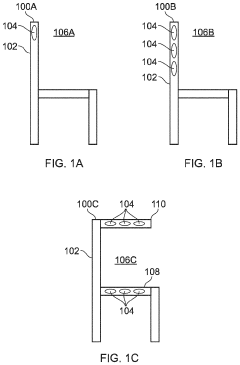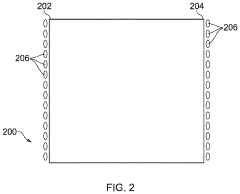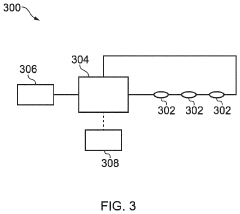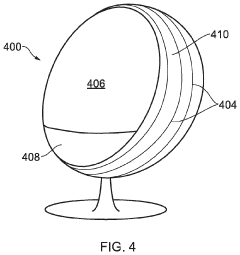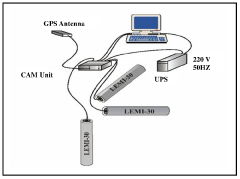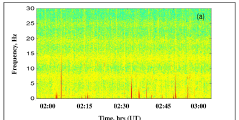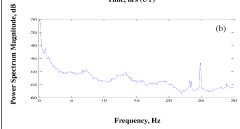How to Track Schumann Resonance Changes Over Time?
JUN 24, 20259 MIN READ
Generate Your Research Report Instantly with AI Agent
Patsnap Eureka helps you evaluate technical feasibility & market potential.
Schumann Resonance Background and Objectives
The Schumann resonance, discovered by physicist Winfried Otto Schumann in 1952, is a set of spectrum peaks in the extremely low frequency (ELF) portion of the Earth's electromagnetic field spectrum. These resonances occur between the Earth's surface and the ionosphere, creating a global electromagnetic resonance phenomenon. The fundamental frequency of the Schumann resonance is approximately 7.83 Hz, with harmonics at higher frequencies.
Tracking changes in the Schumann resonance over time has become increasingly important in various scientific fields, including atmospheric science, geophysics, and even potential applications in human health research. The primary objective of monitoring these changes is to gain insights into global atmospheric dynamics, ionospheric conditions, and potential correlations with various terrestrial and space weather phenomena.
The evolution of technology has significantly enhanced our ability to measure and analyze Schumann resonance fluctuations. From early rudimentary detection methods to modern sophisticated sensor networks and data processing techniques, the field has seen remarkable progress. This technological advancement has opened up new possibilities for long-term, high-resolution monitoring of Schumann resonance variations.
One of the key goals in tracking Schumann resonance changes is to establish baseline measurements and identify patterns or anomalies that may be indicative of larger-scale environmental or atmospheric changes. This includes studying potential links between Schumann resonance variations and global climate patterns, solar activity, or even seismic events.
Another important objective is to develop standardized methodologies for data collection, analysis, and interpretation. This standardization is crucial for creating a global network of monitoring stations that can provide consistent, comparable data across different geographical locations and time scales.
Furthermore, researchers aim to explore the potential applications of Schumann resonance monitoring in various fields. This includes its use as a potential early warning system for certain types of natural disasters, its application in space weather forecasting, and its possible implications for human health and circadian rhythms.
As we delve deeper into the study of Schumann resonance changes, the ultimate goal is to enhance our understanding of the Earth's electromagnetic environment and its interactions with various natural phenomena. This knowledge could potentially lead to breakthroughs in climate science, geophysical research, and even contribute to the development of novel technologies that leverage the Earth's natural electromagnetic field.
Tracking changes in the Schumann resonance over time has become increasingly important in various scientific fields, including atmospheric science, geophysics, and even potential applications in human health research. The primary objective of monitoring these changes is to gain insights into global atmospheric dynamics, ionospheric conditions, and potential correlations with various terrestrial and space weather phenomena.
The evolution of technology has significantly enhanced our ability to measure and analyze Schumann resonance fluctuations. From early rudimentary detection methods to modern sophisticated sensor networks and data processing techniques, the field has seen remarkable progress. This technological advancement has opened up new possibilities for long-term, high-resolution monitoring of Schumann resonance variations.
One of the key goals in tracking Schumann resonance changes is to establish baseline measurements and identify patterns or anomalies that may be indicative of larger-scale environmental or atmospheric changes. This includes studying potential links between Schumann resonance variations and global climate patterns, solar activity, or even seismic events.
Another important objective is to develop standardized methodologies for data collection, analysis, and interpretation. This standardization is crucial for creating a global network of monitoring stations that can provide consistent, comparable data across different geographical locations and time scales.
Furthermore, researchers aim to explore the potential applications of Schumann resonance monitoring in various fields. This includes its use as a potential early warning system for certain types of natural disasters, its application in space weather forecasting, and its possible implications for human health and circadian rhythms.
As we delve deeper into the study of Schumann resonance changes, the ultimate goal is to enhance our understanding of the Earth's electromagnetic environment and its interactions with various natural phenomena. This knowledge could potentially lead to breakthroughs in climate science, geophysical research, and even contribute to the development of novel technologies that leverage the Earth's natural electromagnetic field.
Market Analysis for Schumann Resonance Monitoring
The market for Schumann Resonance monitoring is experiencing significant growth, driven by increasing awareness of its potential applications in various fields. Schumann Resonances, the natural electromagnetic frequencies of the Earth's ionosphere cavity, have garnered attention from researchers, environmental scientists, and health professionals due to their potential impact on human health and environmental monitoring.
The global market for Schumann Resonance monitoring equipment and services is projected to expand at a steady rate over the next five years. This growth is primarily fueled by the rising demand for advanced environmental monitoring systems and the increasing interest in studying the Earth's electromagnetic field for potential correlations with climate change, seismic activity, and human health.
Key market segments for Schumann Resonance monitoring include scientific research institutions, environmental monitoring agencies, and healthcare organizations. The scientific research sector currently dominates the market, with universities and government research facilities investing in sophisticated monitoring equipment to study long-term changes in the Earth's electromagnetic environment.
Environmental monitoring agencies are emerging as a significant market segment, utilizing Schumann Resonance data to complement existing climate and atmospheric monitoring systems. This integration allows for a more comprehensive understanding of global environmental changes and potential early warning indicators for extreme weather events.
The healthcare sector represents a growing niche within the Schumann Resonance monitoring market. Some researchers are exploring potential links between Schumann Resonance fluctuations and human health, including effects on circadian rhythms and overall well-being. While still in its early stages, this area shows promise for future market expansion.
Geographically, North America and Europe currently lead the market for Schumann Resonance monitoring equipment and services, due to the concentration of research institutions and advanced environmental monitoring networks in these regions. However, the Asia-Pacific region is expected to show the fastest growth in the coming years, driven by increasing environmental concerns and investments in scientific research infrastructure.
The market is characterized by a mix of established scientific instrument manufacturers and specialized niche players. Key market drivers include technological advancements in sensor technology, increasing concerns about climate change and its effects, and growing interest in the potential health implications of electromagnetic fields.
Challenges facing the market include the need for standardization in measurement techniques and data interpretation, as well as the relatively high cost of advanced monitoring equipment. However, ongoing research and development efforts are expected to address these challenges, potentially leading to more accessible and cost-effective monitoring solutions in the future.
The global market for Schumann Resonance monitoring equipment and services is projected to expand at a steady rate over the next five years. This growth is primarily fueled by the rising demand for advanced environmental monitoring systems and the increasing interest in studying the Earth's electromagnetic field for potential correlations with climate change, seismic activity, and human health.
Key market segments for Schumann Resonance monitoring include scientific research institutions, environmental monitoring agencies, and healthcare organizations. The scientific research sector currently dominates the market, with universities and government research facilities investing in sophisticated monitoring equipment to study long-term changes in the Earth's electromagnetic environment.
Environmental monitoring agencies are emerging as a significant market segment, utilizing Schumann Resonance data to complement existing climate and atmospheric monitoring systems. This integration allows for a more comprehensive understanding of global environmental changes and potential early warning indicators for extreme weather events.
The healthcare sector represents a growing niche within the Schumann Resonance monitoring market. Some researchers are exploring potential links between Schumann Resonance fluctuations and human health, including effects on circadian rhythms and overall well-being. While still in its early stages, this area shows promise for future market expansion.
Geographically, North America and Europe currently lead the market for Schumann Resonance monitoring equipment and services, due to the concentration of research institutions and advanced environmental monitoring networks in these regions. However, the Asia-Pacific region is expected to show the fastest growth in the coming years, driven by increasing environmental concerns and investments in scientific research infrastructure.
The market is characterized by a mix of established scientific instrument manufacturers and specialized niche players. Key market drivers include technological advancements in sensor technology, increasing concerns about climate change and its effects, and growing interest in the potential health implications of electromagnetic fields.
Challenges facing the market include the need for standardization in measurement techniques and data interpretation, as well as the relatively high cost of advanced monitoring equipment. However, ongoing research and development efforts are expected to address these challenges, potentially leading to more accessible and cost-effective monitoring solutions in the future.
Current Challenges in Tracking Schumann Resonance
Tracking Schumann Resonance (SR) changes over time presents several significant challenges that researchers and scientists must overcome. One of the primary difficulties lies in the low-frequency nature of SR signals, typically ranging from 7.83 Hz to 45 Hz. These frequencies are susceptible to various forms of interference, including natural and anthropogenic sources, making it challenging to isolate and accurately measure SR signals.
The global distribution of SR signals adds another layer of complexity to tracking changes. As SR is a global phenomenon, influenced by worldwide lightning activity and ionospheric conditions, obtaining a comprehensive picture requires a network of monitoring stations spread across different geographical locations. Establishing and maintaining such a network is both logistically challenging and financially demanding.
Environmental factors pose additional hurdles in SR tracking. Variations in local weather conditions, geomagnetic activity, and solar influences can all affect SR measurements. Distinguishing between genuine SR changes and these environmental fluctuations requires sophisticated data analysis techniques and long-term monitoring to establish baseline patterns.
The need for high-sensitivity equipment presents another challenge. Detecting and measuring SR signals accurately demands specialized, highly sensitive magnetometers and antennas. These instruments must be capable of operating continuously over extended periods while maintaining consistent performance and calibration. The cost and maintenance of such equipment can be prohibitive for many research institutions.
Data processing and analysis present their own set of challenges. The vast amount of data generated by continuous monitoring requires robust storage solutions and advanced processing algorithms. Extracting meaningful trends and patterns from this data, while filtering out noise and anomalies, demands significant computational resources and expertise in signal processing and data analysis.
Temporal resolution is another critical factor in tracking SR changes. While some variations occur over long periods, others may be more rapid, necessitating continuous, high-resolution monitoring. Balancing the need for detailed temporal data with the practical limitations of data storage and processing capabilities remains an ongoing challenge.
Lastly, the interpretation of SR changes poses a significant challenge. Correlating observed variations with specific global phenomena, such as climate change, solar activity, or large-scale weather patterns, requires interdisciplinary expertise and collaborative efforts across various scientific fields. The complexity of the Earth-ionosphere system makes it difficult to establish clear causal relationships between SR changes and specific environmental or geophysical factors.
The global distribution of SR signals adds another layer of complexity to tracking changes. As SR is a global phenomenon, influenced by worldwide lightning activity and ionospheric conditions, obtaining a comprehensive picture requires a network of monitoring stations spread across different geographical locations. Establishing and maintaining such a network is both logistically challenging and financially demanding.
Environmental factors pose additional hurdles in SR tracking. Variations in local weather conditions, geomagnetic activity, and solar influences can all affect SR measurements. Distinguishing between genuine SR changes and these environmental fluctuations requires sophisticated data analysis techniques and long-term monitoring to establish baseline patterns.
The need for high-sensitivity equipment presents another challenge. Detecting and measuring SR signals accurately demands specialized, highly sensitive magnetometers and antennas. These instruments must be capable of operating continuously over extended periods while maintaining consistent performance and calibration. The cost and maintenance of such equipment can be prohibitive for many research institutions.
Data processing and analysis present their own set of challenges. The vast amount of data generated by continuous monitoring requires robust storage solutions and advanced processing algorithms. Extracting meaningful trends and patterns from this data, while filtering out noise and anomalies, demands significant computational resources and expertise in signal processing and data analysis.
Temporal resolution is another critical factor in tracking SR changes. While some variations occur over long periods, others may be more rapid, necessitating continuous, high-resolution monitoring. Balancing the need for detailed temporal data with the practical limitations of data storage and processing capabilities remains an ongoing challenge.
Lastly, the interpretation of SR changes poses a significant challenge. Correlating observed variations with specific global phenomena, such as climate change, solar activity, or large-scale weather patterns, requires interdisciplinary expertise and collaborative efforts across various scientific fields. The complexity of the Earth-ionosphere system makes it difficult to establish clear causal relationships between SR changes and specific environmental or geophysical factors.
Existing Schumann Resonance Tracking Solutions
01 Measurement and monitoring of Schumann resonance changes
Various devices and methods are developed to measure and monitor changes in Schumann resonance. These systems often include sensors, antennas, and signal processing units to detect and analyze electromagnetic waves in the extremely low frequency (ELF) range associated with Schumann resonances. The data collected can be used for environmental monitoring, geophysical research, and potential health applications.- Measurement and monitoring of Schumann resonance changes: Various devices and methods are developed to measure and monitor changes in Schumann resonance. These systems typically include sensors, signal processing units, and data analysis tools to detect and analyze variations in the Earth's electromagnetic field. The monitoring of Schumann resonance changes can provide insights into global electromagnetic phenomena and potential environmental impacts.
- Applications of Schumann resonance in health and wellness: Schumann resonance is being explored for its potential health benefits. Devices and methods are developed to generate or simulate Schumann resonance frequencies for therapeutic purposes. These applications aim to improve human well-being by aligning the body's natural rhythms with the Earth's electromagnetic frequencies.
- Integration of Schumann resonance in electronic devices: Schumann resonance technology is being incorporated into various electronic devices and systems. This integration aims to enhance the functionality of these devices or to provide additional features related to electromagnetic field detection or generation. Examples include mobile devices, wearables, and home appliances designed to interact with or utilize Schumann resonance.
- Environmental monitoring using Schumann resonance: Schumann resonance changes are being utilized as indicators for environmental monitoring and forecasting. Systems and methods are developed to analyze these changes in relation to various environmental factors, potentially aiding in the prediction of natural phenomena or the assessment of global environmental conditions.
- Schumann resonance in communication and signal processing: The characteristics of Schumann resonance are being explored for potential applications in communication systems and signal processing. This includes the development of novel communication methods that utilize the Earth's electromagnetic field, as well as signal processing techniques that can filter or utilize Schumann resonance frequencies for various purposes.
02 Therapeutic applications of Schumann resonance
Devices and methods are designed to utilize Schumann resonance for therapeutic purposes. These may include wearable devices, room-scale generators, or specialized equipment that produce electromagnetic fields mimicking or enhancing natural Schumann resonance frequencies. The applications range from stress reduction and sleep improvement to potential benefits for various health conditions.Expand Specific Solutions03 Integration of Schumann resonance in electronic devices
Schumann resonance generators or simulators are integrated into various electronic devices and appliances. This includes incorporation into air purifiers, ionizers, lighting systems, and other household or personal devices. The aim is to create a more natural electromagnetic environment in indoor spaces or to enhance the functionality of existing products.Expand Specific Solutions04 Schumann resonance in communication and navigation systems
Research and development efforts focus on utilizing Schumann resonance characteristics in communication and navigation systems. This includes potential applications in long-range, low-frequency communication, underwater communication, and navigation systems that could complement or provide alternatives to existing technologies.Expand Specific Solutions05 Environmental and geophysical applications
Schumann resonance monitoring is applied in environmental and geophysical studies. Systems are developed to use Schumann resonance data for tracking global temperature changes, monitoring ionospheric conditions, and potentially predicting seismic activities. These applications contribute to broader understanding of Earth's electromagnetic environment and its changes.Expand Specific Solutions
Key Players in Schumann Resonance Research
The tracking of Schumann Resonance changes over time is an emerging field at the intersection of geophysics and electromagnetic research. The market is in its early development stage, with a growing interest from both academic institutions and private companies. The global market size for Schumann Resonance monitoring equipment and related technologies is relatively small but expanding. Technologically, the field is still maturing, with companies like Siemens Healthineers AG, Exxonmobil Upstream Research Co., and Schlumberger Technologies, Inc. investing in research and development. Universities such as Chongqing University of Posts & Telecommunications and Beijing Jiaotong University are also contributing to advancements in this area, indicating a collaborative approach between industry and academia to push the boundaries of Schumann Resonance tracking capabilities.
Chongqing University of Posts & Telecommunications
Technical Solution: The university has developed a novel approach to track Schumann Resonance changes over time using advanced signal processing techniques and machine learning algorithms. Their method involves deploying a network of highly sensitive magnetometers across various locations to capture the extremely low frequency (ELF) electromagnetic signals associated with Schumann Resonances. The collected data is then processed using adaptive filtering to remove noise and interference, followed by spectral analysis to identify the characteristic Schumann Resonance peaks. Machine learning models are employed to detect subtle changes in the resonance patterns over time, correlating these variations with various geophysical and atmospheric phenomena.
Strengths: High sensitivity and accuracy in detecting subtle changes; ability to correlate resonance variations with other environmental factors. Weaknesses: Requires a extensive network of sensors for comprehensive coverage; may be affected by local electromagnetic interference.
Lanzhou Institute of Space Technology Physics
Technical Solution: The institute has developed a space-based Schumann Resonance monitoring system using satellites equipped with specialized ELF receivers. This innovative approach allows for continuous global monitoring of Schumann Resonances, overcoming the limitations of ground-based systems. The satellite-based sensors capture ELF signals from various altitudes, providing a three-dimensional view of the Earth's electromagnetic environment. Advanced onboard processing algorithms filter out space-based interference and isolate the Schumann Resonance signals. The data is then transmitted to ground stations for further analysis, where long-term trends and variations are tracked using sophisticated time-series analysis techniques and artificial intelligence algorithms.
Strengths: Global coverage; ability to monitor Schumann Resonances from different altitudes; less affected by ground-based interference. Weaknesses: High cost of satellite deployment and maintenance; potential challenges in distinguishing Schumann Resonances from other space-based electromagnetic phenomena.
Core Technologies for Schumann Resonance Measurement
A magnetic field exposure system and uses thereof
PatentPendingUS20230372726A1
Innovation
- A magnetic field exposure system generating an amplitude-modulated low frequency magnetic field with a carrier frequency of 360 to 450 Hz and a modulation frequency of 0.5 to 100 Hz, providing a field strength of 0.5 to 250 μT, specifically designed to enhance cell survival, proliferation, reduce stress, and promote tissue regeneration.
Noval strategy of schumann resonance phenomena at a low latitude stationand their estabilishment thereof
PatentInactiveIN202011054143A
Innovation
- The use of three-component search coil magnetometers (LEMI-30) installed at low latitude stations to measure magnetic field variations, combined with GPS synchronization and data analysis using MATLAB, to record and analyze Schumann resonance phenomena, allowing for the isolation of Schumann signals and correlation with ground surface temperature for environmental monitoring.
Environmental Factors Affecting Schumann Resonance
The Schumann resonance, a set of spectral peaks in the Earth's electromagnetic field spectrum, is influenced by various environmental factors that can cause changes in its frequency and amplitude over time. One of the primary factors affecting Schumann resonance is solar activity. Solar flares and coronal mass ejections can significantly impact the Earth's ionosphere, altering its conductivity and height, which in turn affects the Schumann resonance.
Seasonal variations also play a crucial role in modulating Schumann resonance. The intensity of lightning activity, which is the main driver of Schumann resonance, varies with seasons. During summer months, when thunderstorm activity is more prevalent, the Schumann resonance tends to exhibit higher amplitudes. Conversely, winter months typically show lower amplitudes due to reduced lightning activity.
Geomagnetic storms, caused by interactions between the Earth's magnetosphere and solar wind, can lead to notable changes in Schumann resonance. These storms can alter the ionospheric conditions, resulting in frequency shifts and amplitude variations in the resonance.
Climate change and global warming have also been observed to impact Schumann resonance. As global temperatures rise, there is an increase in the frequency and intensity of extreme weather events, including thunderstorms. This can lead to long-term changes in the characteristics of Schumann resonance.
Human activities, particularly those involving large-scale electromagnetic emissions, can potentially influence Schumann resonance. Industrial activities, power grids, and communication systems may contribute to local or regional variations in the Earth's electromagnetic field, affecting the resonance patterns.
Atmospheric composition changes, such as variations in greenhouse gas concentrations or aerosol levels, can indirectly affect Schumann resonance by altering atmospheric conductivity and the dynamics of lightning activity.
Geological events, including earthquakes and volcanic eruptions, may also impact Schumann resonance. These events can cause localized changes in the Earth's electromagnetic field and potentially influence the global resonance patterns.
Understanding these environmental factors and their complex interactions is crucial for accurately tracking and interpreting changes in Schumann resonance over time. Long-term monitoring and analysis of these factors alongside Schumann resonance measurements can provide valuable insights into global electromagnetic phenomena and their relationship with Earth's climate and geophysical processes.
Seasonal variations also play a crucial role in modulating Schumann resonance. The intensity of lightning activity, which is the main driver of Schumann resonance, varies with seasons. During summer months, when thunderstorm activity is more prevalent, the Schumann resonance tends to exhibit higher amplitudes. Conversely, winter months typically show lower amplitudes due to reduced lightning activity.
Geomagnetic storms, caused by interactions between the Earth's magnetosphere and solar wind, can lead to notable changes in Schumann resonance. These storms can alter the ionospheric conditions, resulting in frequency shifts and amplitude variations in the resonance.
Climate change and global warming have also been observed to impact Schumann resonance. As global temperatures rise, there is an increase in the frequency and intensity of extreme weather events, including thunderstorms. This can lead to long-term changes in the characteristics of Schumann resonance.
Human activities, particularly those involving large-scale electromagnetic emissions, can potentially influence Schumann resonance. Industrial activities, power grids, and communication systems may contribute to local or regional variations in the Earth's electromagnetic field, affecting the resonance patterns.
Atmospheric composition changes, such as variations in greenhouse gas concentrations or aerosol levels, can indirectly affect Schumann resonance by altering atmospheric conductivity and the dynamics of lightning activity.
Geological events, including earthquakes and volcanic eruptions, may also impact Schumann resonance. These events can cause localized changes in the Earth's electromagnetic field and potentially influence the global resonance patterns.
Understanding these environmental factors and their complex interactions is crucial for accurately tracking and interpreting changes in Schumann resonance over time. Long-term monitoring and analysis of these factors alongside Schumann resonance measurements can provide valuable insights into global electromagnetic phenomena and their relationship with Earth's climate and geophysical processes.
Data Analysis Techniques for Schumann Resonance Trends
Data analysis techniques play a crucial role in tracking Schumann Resonance changes over time. These techniques involve a combination of signal processing, statistical analysis, and data visualization methods to extract meaningful information from raw electromagnetic measurements.
One of the primary techniques used is spectral analysis, which involves transforming time-domain signals into frequency-domain representations. Fast Fourier Transform (FFT) is commonly employed to decompose the complex Schumann Resonance waveforms into their constituent frequency components. This allows researchers to identify and track changes in the fundamental resonance frequencies and their harmonics.
Time-frequency analysis methods, such as Short-Time Fourier Transform (STFT) and wavelet transforms, are valuable for capturing temporal variations in Schumann Resonance signals. These techniques provide insights into how the resonance frequencies and amplitudes evolve over different time scales, from minutes to years.
Statistical methods are essential for quantifying trends and patterns in Schumann Resonance data. Time series analysis techniques, including moving averages, exponential smoothing, and autoregressive integrated moving average (ARIMA) models, help in identifying long-term trends, seasonal patterns, and anomalies in the resonance parameters.
Machine learning algorithms are increasingly being applied to Schumann Resonance data analysis. Clustering techniques can identify distinct patterns or states in the resonance behavior, while classification algorithms can be used to detect and categorize specific events or disturbances in the Earth-ionosphere cavity.
Data visualization plays a critical role in interpreting and communicating Schumann Resonance trends. Spectrograms, which display frequency content over time, are particularly useful for visualizing dynamic changes in resonance patterns. Heat maps and contour plots can effectively represent spatial variations in resonance parameters across different monitoring stations.
Correlation analysis techniques are employed to investigate relationships between Schumann Resonance changes and other geophysical or atmospheric phenomena. This includes examining correlations with solar activity, geomagnetic indices, and global lightning activity.
To handle the large volumes of data generated by continuous Schumann Resonance monitoring, big data analytics and distributed computing frameworks are often utilized. These tools enable efficient processing and analysis of long-term datasets, facilitating the detection of subtle trends and anomalies that may not be apparent in shorter-term observations.
One of the primary techniques used is spectral analysis, which involves transforming time-domain signals into frequency-domain representations. Fast Fourier Transform (FFT) is commonly employed to decompose the complex Schumann Resonance waveforms into their constituent frequency components. This allows researchers to identify and track changes in the fundamental resonance frequencies and their harmonics.
Time-frequency analysis methods, such as Short-Time Fourier Transform (STFT) and wavelet transforms, are valuable for capturing temporal variations in Schumann Resonance signals. These techniques provide insights into how the resonance frequencies and amplitudes evolve over different time scales, from minutes to years.
Statistical methods are essential for quantifying trends and patterns in Schumann Resonance data. Time series analysis techniques, including moving averages, exponential smoothing, and autoregressive integrated moving average (ARIMA) models, help in identifying long-term trends, seasonal patterns, and anomalies in the resonance parameters.
Machine learning algorithms are increasingly being applied to Schumann Resonance data analysis. Clustering techniques can identify distinct patterns or states in the resonance behavior, while classification algorithms can be used to detect and categorize specific events or disturbances in the Earth-ionosphere cavity.
Data visualization plays a critical role in interpreting and communicating Schumann Resonance trends. Spectrograms, which display frequency content over time, are particularly useful for visualizing dynamic changes in resonance patterns. Heat maps and contour plots can effectively represent spatial variations in resonance parameters across different monitoring stations.
Correlation analysis techniques are employed to investigate relationships between Schumann Resonance changes and other geophysical or atmospheric phenomena. This includes examining correlations with solar activity, geomagnetic indices, and global lightning activity.
To handle the large volumes of data generated by continuous Schumann Resonance monitoring, big data analytics and distributed computing frameworks are often utilized. These tools enable efficient processing and analysis of long-term datasets, facilitating the detection of subtle trends and anomalies that may not be apparent in shorter-term observations.
Unlock deeper insights with Patsnap Eureka Quick Research — get a full tech report to explore trends and direct your research. Try now!
Generate Your Research Report Instantly with AI Agent
Supercharge your innovation with Patsnap Eureka AI Agent Platform!
